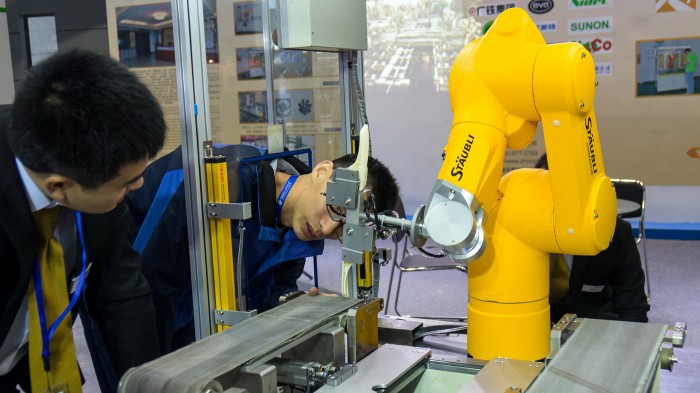Rise of the Immigrant Robo-Laborers

From oil rigs to farms, more of the country's workplaces than ever are now welcoming robotic laborers. That spells lower costs for the companies that employ them, but it could be an awkward moment for the new president, whose pro-business stance and "America first" populism will have to contend with the fact that many of the machines will be made in China.
Robots have a long track record of piecing together complex products like cars and consumer electronics. As their role in factory settings continues to expand, they are also now being used in more unpredictable settings. Bloomberg reports, for example, that oil drilling sites are becoming increasingly automated, with robots taking over the job of joining heavy pipes as they’re driven into wells. One oil company says that wells that previously required 20 employees may soon need as few as five.
Meanwhile, the rising price of workers is driving some farmers of labor-intensive crops—such as fresh fruits and vegetables—to adopt robots. As both Forbes and Bloomberg report, the devices can currently be used to pick crops or thin out seedlings, and, despite their high upfront costs, don’t demand a minimum wage. The mining industry is undergoing similar changes, and even construction sites may soon get a robotic helping hand.
It all sounds like a lot of jobs are at stake. And it’s certainly true that many traditional roles will be lost to robots. But as a recent report suggested, it will probably be a while yet before robots gobble up jobs en masse.
Instead, the U.S. might choose to worry about where these robots actually come from. As Farhad Manjoo points out in the New York Times, many of the machines that will be used to automate jobs in America will come from China. The U.S. hasn’t invested heavily in building commercial robots, while China has been busy building an army of them.
Manjoo argues that President Trump would be well-served by working to expand the investment in companies that make industrial robots domestically—but that political move wouldn’t sit well with his stated desire to boost job growth. Instead, he might have to face up to the fact that his desire to help U.S. businesses will be built, in part at least, on a foundation of Chinese robots. And something other than a wall would be required to keep those workers out.
(Read more: Bloomberg, Forbes, “China Is Building a Robot Army of Model Workers,” “Robot, Get the Fork Out of My Sink,” “Robots Will Devour Jobs More Slowly Than You Think”)
Keep Reading
Most Popular
Large language models can do jaw-dropping things. But nobody knows exactly why.
And that's a problem. Figuring it out is one of the biggest scientific puzzles of our time and a crucial step towards controlling more powerful future models.
How scientists traced a mysterious covid case back to six toilets
When wastewater surveillance turns into a hunt for a single infected individual, the ethics get tricky.
The problem with plug-in hybrids? Their drivers.
Plug-in hybrids are often sold as a transition to EVs, but new data from Europe shows we’re still underestimating the emissions they produce.
Stay connected
Get the latest updates from
MIT Technology Review
Discover special offers, top stories, upcoming events, and more.